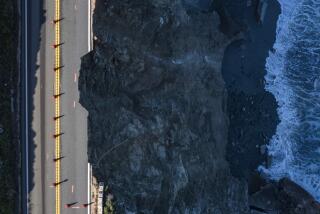New York Residents File Suit in Effort to Regain the Road Less Traveled
- Share via
CHESHIRE, N.Y. — All his life, Brad Bliss dreamed of building a home at the end of a dirt road, where “all you would ever hear at night was the very distant sound of a vehicle on a highway far, far away.”
In 1992, their children grown, the 54-year-old investment broker and his wife found their spot off an unpaved country byway deep in the Bristol Hills, a 20-acre retreat for deer, wild turkey and the occasional bear.
“It’s hard to go in at night,” Bliss said.
But lately, he said, the solitude has been shattered. And as if to prove his point, a pickup truck with a stranger behind the wheel zoomed by.
Knapp Road, 1 1/2 miles of light-brown packed soil and gravel that rises, falls and winds through a pine forest, is now topped with a dull gray layer of crushed stone.
Look carefully and you can see the dead bodies it is paved over. The new and improved Knapp Road is a road more taken but less loved.
Police were sent to stand guard when the highway crew did its work in June--there had been protests, and authorities feared there would be unpleasantness. Now, a majority of the more than 50 residents of Knapp Road have filed suit to have their dirt road restored.
They say traffic has nearly doubled. Outsiders are discovering the new shortcut near the Finger Lakes town of Canandaigua. Instead of cars worming along at 30 mph, some reach 50 mph or more.
“I never heard the road before. Now I hear it--oh, yeah!” Bliss exclaimed, unable to stifle his anger.
In winter, he said, nearby Bristol Mountain ski resort will draw its throngs, and “that’s when the traffic will really become dangerous”--not only to children cycling along the road, but to wildlife venturing across it.
The protesters staged rallies outside highway department barns and packed town hall meetings, but their appeals were dismissed in late May by a Canandaigua town board that wants to stick to a 1987 plan to upgrade all its country roads. Just 15 miles of publicly maintained dirt roads remain.
“The goal was to get ‘em all covered. To me, that’s still the goal,” said town highway superintendent Jim Hecker.
He said a hard surface will be cheaper to maintain in the long run, eliminate hazards of summer dust and winter ice slicks and be more accessible for ambulances, school buses and plows.
If residents want a dirt road, he said, “they need to live on a private road, so they control the maintenance of it 100%.”
A proposal to widen the 20-foot road, which would mean clearing trees, was nixed.
“I did try to mitigate their concerns,” Hecker said.
But the opponents were not appeased. And rather than wait as planned to pave the road in July, Hecker decided he “didn’t want any hostility building and building” and moved crews off other projects to get the job done in half a day.
The dissidents cried foul. They suggested Hecker acted out of spite when they resorted to a media campaign to get their point across.
“They think we’re a bunch of hillbillies--most of us are college-educated people,” said Janet Acquilano, a mother of three who fears her 11-year-old daughter will no longer be safe cycling along the road.
Dirt roads, she lamented, could one day “become just a page in a history book. This is our last chance to keep nature a part of our everyday lives.”
Opponents worry that the town might have an underlying desire to develop the region, still sparsely populated but growing in popularity. Big log houses have sprung up of late on lots zoned to be no smaller than 3 acres.
The town had failed to conduct the proper environmental impact studies and had violated the opponents’ freedom of speech, their lawyer, Alan Knauf, alleged in a lawsuit that seeks to have the paving removed.
Herbert Gottfried, a professor of landscape architecture at Cornell University, said the residents’ crusade is “absolutely American.”
“It’s what the dirt road connotes: living someplace in between the wild and the city,” he said. “But to have a majority of people believing in the same illusion is quite amazing these days, since there’s so much emphasis on everybody doing their own thing.”
Was Knapp Road paved with good intentions? Hecker insists it was, but as he runs for reelection, he wonders whether he will ever convince his adversaries of that.
“If any of your friends or relatives ever talk about running for highway superintendent, talk them out of it,” he said with a bitter laugh. “There’s no end to the 14-hour days, there’s no end to the criticism.”
More to Read
Sign up for Essential California
The most important California stories and recommendations in your inbox every morning.
You may occasionally receive promotional content from the Los Angeles Times.










